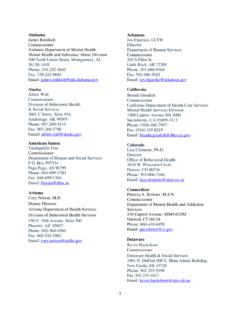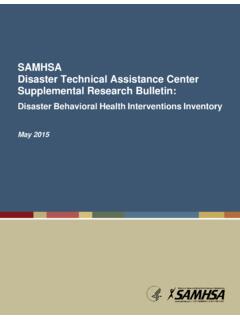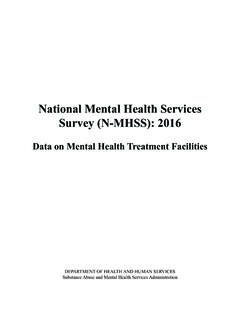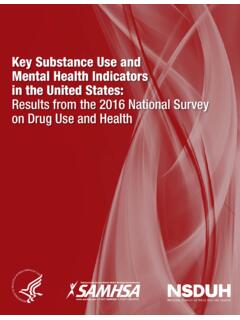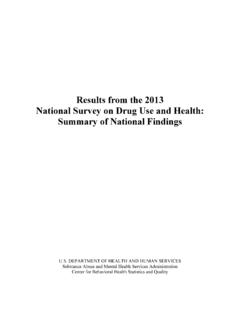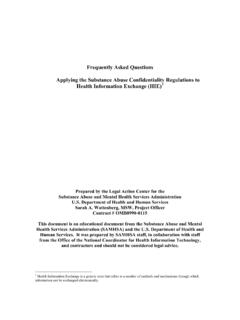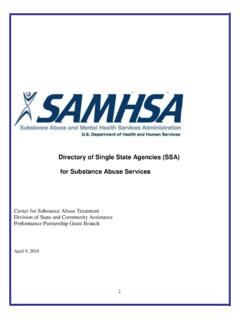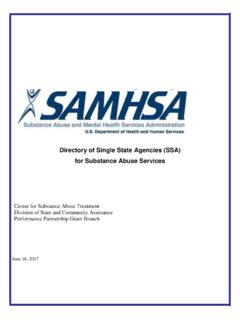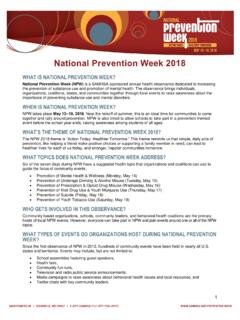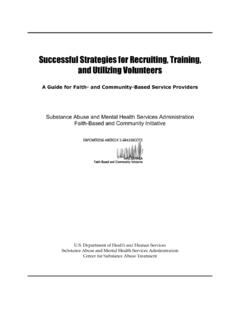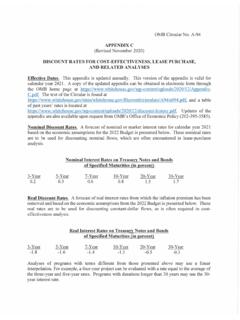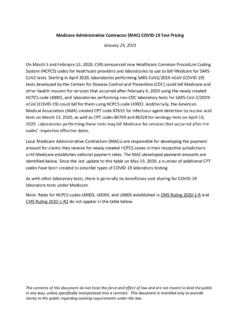Transcription of Double Jeopardy: COVID-19 and Behavioral Health ...
1 Double Jeopardy: COVID-19 and Behavioral Health Disparities for Black and Latino Communities in the (Submitted by OBHE) The Impact of COVID-19 on Black and Latino Communities The coronavirus ( COVID-19 ) pandemic has revealed deep-seated inequities in Health care for communities of color and amplifies social and economic factors that contribute to poor Health outcomes. Recent news reports indicate that the pandemic disproportionately impacts communities of color, compounding longstanding racial disparities. As of April 15, 2020, case data from CDC show that in COVID-19 cases where race was specified, Blacks, who comprise 13 percent of the total population ( Census Bureau, 2018), make up 30 percent of COVID-19 cases; Latinos, who make up 18 percent of the population ( Census Bureau, 2018), account for 17 percent of COVID-19 cases.
2 Similarly, hospitalization rates due to COVID-19 disproportionately affect Blacks (see CDC infographic). Disparities in identified cases and deaths also vary across states, with a disproportionately high percentage of Blacks and Latinos affected as shown below (Kaiser Family Foundation, 2020; CDC, 2020; Census Bureau). 39%32%14%45%21%39%48%33%37%56%70%41%59%4 5%0%10%20%30%40%50%60%70%80%Illinois, People of ColorLouisiana, BlacksMichigan, BlacksWashington, DC., BlacksNorth Carolina, BlacksCalifornia, LatinosPercentage of Blacks, Latinos, and People of Color by State Population, COVID-19 Cases, and COVID-19 Deaths (Kaiser Family Foundation, CDC, US Census Bureau) COVID-19 DeathsCovid-19 CasesState Population People of color are: at an increased risk for serious illness if they contract COVID-19 due to higher rates of underlying Health conditions, such as diabetes, asthma, hypertension, and obesity compared to Whites; more likely to be uninsured and to lack a usual source of care which is an impediment to accessing COVID-19 testing and treatment services; more likely to work in the service industries such as restaurants, retail, and hospitality that are particularly at risk for loss of income during the pandemic.
3 More likely to live in housing situations, such as multigenerational families or low-income and public housing that make it difficult to social distance or self-isolate; and often working in jobs that are not amenable to teleworking and use public transportation that puts them at risk for exposure to COVID-19 . ( Kaiser Family Foundation, 2020; Health Affairs, 2020) 2 Compounding Behavioral Health Issues The COVID-19 pandemic has spotlighted racial and ethnic disparities in access to Behavioral Health care. While their rates of Behavioral Health disorders may not significantly differ from the general population, Blacks and Latinos have substantially lower access to mental Health and substance-use treatment services as shown below. (NSDUH, 2020). Given the existing impediments to care for Blacks and Latinos due to social determinants of Health , COVID-19 pandemic will place those with Behavioral Health problems at even higher vulnerability.
4 Blacks and Latinos have lower access to needed treatment, often terminate treatment prematurely, and 3 experience less culturally responsive care. A recentindicates that Hispanics were significantly more likely than the general population to see COVID-19 as a major threat to their Health and finances. In terms of substance use, Black and Latino communities are continuing to deal with the opioid epidemic while now in the midst of the COVID-19 pandemic. Specifically: report Blacks and Latinos have limited access to prevention, treatment, and recovery services for substance use disorders. While they have similar rates of opioid misuse as the general population, in recent years Blacks have experienced the greatest increase in rate for overdose deaths from non-methadone synthetic opioids ( SAMHSA, 2020).
5 Strategies are needed to prevent disruption of substance use treatment and recovery services, increase capacity for telehealth, and support individuals with substance use disorders and serious mental illnesses who have COVID-19 . Disruption of recovery support groups, closing of clinics, and cutting harm reduction efforts such as syringe service programs may trigger relapses and increase rates of hepatitis and HIV. Blacks and Latinos with mental Health and substance use disorders are more likely to be incarcerated and homeless, than the general population, placing them at increased risk for COVID-19 . Homeless and incarcerated individuals have extreme challenges following CDC guidelines for social distancing, washing hands, and self-quarantining. Incarcerated individuals re-entering the community without adequate treatment, services, and supports may be at higher risk for COVID-19 .
6 What Can We Do? Policy Efforts 1. Data Disaggregation. Data related to COVID-19 , including testing, hospitalizations, ICU admissions, and fatalities, disaggregated by race and ethnicity at the local and national level will help target resources. State case rates are reported to CDC by jurisdictions and through the National Notifiable Diseases Surveillance System (NNDSS), and deaths are posted weekly by race/ethnicity on the CDC National Vital Statistics System, enabling Behavioral Health providers to understand COVID-19 prevalence in their state by race and ethnicity. 2. Flexibility in Treatment Policies and Payments. SAMHSA recently released a guide for opioid treatment programs, enabling them to dispense take-home methadone during the COVID-19 pandemic. SAMHSA is temporarily allowing remote initiation of buprenorphine.
7 This flexibility provides protection for Black and Latinos needing treatment for opioid-use disorders. 3. Navigators for Federal Stimulus Opportunities. The CARES Act provides economic stimulus for small businesses and individuals. The National Network to Eliminate Disparities in Behavioral Health (the NNED) disseminated guidance to its network of 1,200 community-based provider organizations serving racial/ethnic minority populations to apply for the Small Business Administration s Paycheck Protection Program and the IRS s Employment Impact Payments. 4. Expanded and Flexible Coverage for T elehealth. CMS issued guidance for payments for telehealth visits; insurance companies are at least temporarily enhancing coverage for telephone and video Health visits. While the digital divide may reveal less stable internet services in Black and Latino households, smartphones allow for video visits with Health and Behavioral Health providers that meet temporarily-relaxed HIPAA compliance.
8 Communication, Health Literacy, and Public Awareness 1. Language Translation. With the rapidly changing knowledge about COVID-19 , information is changing on a weekly, sometimes daily basis. CDC posts notices and fact sheets in multiple languages. However, the English language materials change on a rapid basis, creating lags in developing translated versions. Timely translation of public Health guidance is critical. 4 2. Culturally Tailoring Messages. Public Health concepts are not readily understandable across cultures. Concepts such as social distancing, flattening the curve, self-quarantining, face-masking, washing hands, and wiping down groceries need to be presented in a culturally-appropriate manner. 3. Establish Communication Channels. Messaging about COVID-19 testing, Behavioral Health services, and federal stimulus opportunities must be accurate, culturally understood, and disseminated through information channels that reach Black and Latino communities.
9 Black or Latino radio, websites such as , and trusted media figures are important messengers. Partnerships with Communities: Leaders and Institutions 1. Faith-based Leaders and Technology. Faith leaders and places of worship play a key role in providing support, information, and spiritual leadership among Black and Latino communities. They are trusted messengers and influencers who often have a history of addressing Health and mental Health promotion. Places of worship are increasingly leveraging technology through radio broadcasts, Zoom sermons, Facebook Live, and podcasts. 2. Community-B ased Organizations (CBOs). Ethnic and racial-specific community-based organizations have established track-records in the community and are often multi-service providers that integrate Health , Behavioral Health , and social services.
10 They are well-positioned to convey COVID-19 information. They often have diverse partnerships and collaborations with schools, higher education, local businesses, law enforcement, jails, and hospitals. Some CBOs host local town hall sessions. The NNED has a locator to find CBOs serving Black and Latino communities. 3. Identify Community-A ccepted First Responders. Due to fears of having children taken out of the home, arrests, or deportations, in some Black and Latino communities, first responders are not necessarily police or emergency medical personnel. Rather, they are extended family members, pastors, neighbors, and other community leaders. It s important to identify these community-determined first responders for disseminating critical information about COVID-19 . Health care Workforce and Practice Efforts 1.
